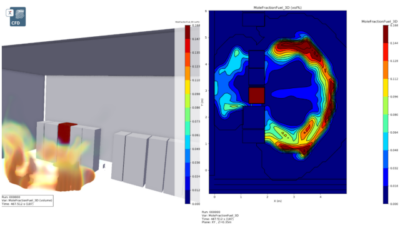Like the rest of the design-build team, the commissioning service provider, often termed the commissioning authority, commissioning agent, or CxA, is contracted to perform a service for the owner. Unlike the mature disciplines of architecture and engineering, the services of the CxA are new and often misunderstood.
Like the rest of the design-build team, the commissioning service provider, often termed the commissioning authority, commissioning agent, or CxA, is contracted to perform a service for the owner. Unlike the mature disciplines of architecture and engineering, the services of the CxA are new and often misunderstood. The CxA can be a person or firm contracted directly by the owner, or it may be subcontracted through any of the conventional players.
Like the casting director of a screenplay, owners must understand the product, know its players, and cast the lead personality that will deliver the best final product. Although price is not mentioned in the above criteria, it is of course a consideration. That being said, the smart consumer will conduct a qualifications-based selection first and consider the commissioning (Cx) finances only in the context of all other factors. Price is a criterion, but it is not the only one.
Cx qualifications
Contrary to popular belief, the CxA is not an agent of the owner, but a quality issues advisor that arms the owner with the knowledge needed to enforce correction through the project’s existing design and construction contracts.
In order to choose the optimal CxA provider, it’s important to consider its technical systems, testing and equipment knowledge, relevant experience, availability, communications skills, certification, and industry involvement, as well as its objectivity on each project.
Technical systems knowledge is critical, for the CxA needs to know how the equipment and systems work. This includes both theoretical (engineering) and practical (operational) knowledge. The two are vastly different, and few excel at both.
Testing knowledge and equipment or the ability to define testing scenarios is different from the ability to install and safely start up a piece of equipment. The ability to run the equipment is different from the “systems” mindset required to test and report on it.
The CxA must have relevant experience as well, in designing, installing, and/or operating the specific equipment and systems being installed. Although there may be overlap between similar building types (for example, institutional facilities like hospitals, offices, and schools), the closer the CxA’s experience is to the project at hand, the better off the owner will be.
Staff availability at the place and time of the project’s design and construction is a must. Since the commissioning process is the longest in the project timeline, the CxA frequently needs to be available for three to five years for a typical building, with months at a time void of activity.
Communications skills are crucial, as the CxA must be able to write the Cx document deliverables as well as communicate with every member of the design/construction team. The field CxA will have to write accurate field reports summarizing complex functional issues; one who “doesn’t write” has no place in the project.
The CxA must have formal training, although such training (and attendant certification) currently varies considerably in class length and rigor. Evidence of industry involvement in the commissioning community is also important and includes attendance at classes and conferences, and delivery of papers and published articles.
Owners should look for a CxA with objectivity. CxAs are often called upon to assess responsibility and confirm correction. They must be able to recommend solutions and confirm correction directly related to quality without prejudicial loyalties to any member of the design/construction team. Their ethical and fiduciary loyalty lies only with the owner.
The cast
The playbill of each design and construction project includes, but is not limited to, the owner (including the owner’s O&M staff), owner’s representative, architect, engineer, construction manager, general contractor, and subcontractors. Objectively, the CxA can be any one of these entities, or a third-party, independent service provider contracted through any of these units to perform services for the project.
Armed with an understanding of Cx requirements, qualifications, and players or delivery methods (listed below), the owner can choose the best combination for the project at hand (see Table 1 for a summary of delivery methods).
Independent third party: With this most common delivery method, the CxA can be an architect, engineer, or contractor, but cannot be an employee of, or subcontractor to, the architecture, engineering, or contracting firms already on the project. Alternatively, the CxA can be a completely independent service provider that performs no project design or installation. The independent third-party CxA reports directly to, and is paid directly by, the owner. This provides the least possibility of a conflict of interest on the project at hand (although conflicts can still occur if the CxA is contracted on other projects with the same parties). This arrangement allows responsive, single-point decision-making and action with no loss in translation when information transfers from the CxA to the owner.
On the downside, this delivery method adds an additional burden on the owner, who has to manage another project contract. For owners with many projects, this can be a considerable problem. Conflicts of another type arise if the CxA is a design firm and is responsible for checking a competitor’s work, or if it is a contractor checking another contractor’s installation. The independent third-party arrangement can work well, however, when the owner is willing to take the time and energy to monitor the CxA.
Project architect or engineer: A CxA within the project architecture or engineering teams will have the best firsthand knowledge of the owner’s design intent and project requirements, since the CxA was part of the earliest project planning. Also, the presence of professional engineers ought to ensure a “systems” approach to the logic behind the HVAC testing process (although, if the engineer is brought on board after all functional aspects have been decided, this might not be the case). On the contrary, if the architect is the CxA, it will have less knowledge of the functioning of the HVAC/MEP systems, which are usually, but not always, the focus of commissioning. The design team likely will have personnel available to commission during construction as that is after their most labor-intensive period prior to bidding.
Given that Cx verifies design through plans and specifications checking, a CxA subcontracted or employed by the design team can compromise an honest and thorough critique of the work unless the design firms are large enough to allow separation between departments or offices. This manner of procurement is only partially acceptable for U.S. Green Building Council LEED projects. Using an independent third party for some of the commissioning tasks can resolve these conflicts of interest.
Owner’s staff: Use of in-house staff is a good choice for a CxA if they have relevant experience and training and are available. The in-house CxA has no conflict of interest with quality, has the most direct communication with the owner, and can be an affordable commissioning solution. In addition, systems knowledge gained during commissioning can give the owner a tremendous advantage. The experience acquired by the owner’s staff in testing building systems will be a big plus in maintaining facility operations during the subsequent years of occupancy.
Cx is a long-term process with long lags in activity between project phases. Few owners have enough projects to warrant a team of qualified CxAs on staff, and they seldom have specialists for emergency generators, UPS systems, on-site sewage treatment, and the like. Moreover, few owners want to maintain an inventory of test equipment. An owner’s staff CxA is acceptable to the USGBC LEED program for both the prerequisite and enhanced commissioning credits. However, an owner should officially verify USGBC LEED requirements for each project.
General contractor: If the general contractor (GC) provides or subcontracts the CxA, the GC’s direct reporting relationship to the owner and communications skills will prove to be an asset. Frequently, GCs also have experience with equipment installation and operation, although never as directly as their subcontractors. The GC is more likely than any other team member to have a “big picture” point of view about systems integration and is the most qualified at administering contracts.
On the negative side, the GC is rarely brought on early in construction projects. GCs often are chosen by low bid and therefore are sure to hold contracts and have a financial stake in the project. This situation will lead to conflicts with quality checkout and testing if the job is late or running close to, or over, budget. This manner of procurement is not acceptable for the USGBC LEED program’s Credit 3 (enhanced commissioning), although it may be acceptable for the commissioning prerequisite credit. Plan to do additional research if you want to use this delivery method to help attain USGBC LEED certification.
MEP subcontractor: MEP subcontractors are the most skilled at operating and testing the equipment they install, and it is efficient for them to commission equipment during their checkout procedure. They are also close to other subcontractors and tend to understand their work well. But this “hands-on” efficiency may be offset by an aversion to report writing and organized databases.
Further, subcontractors are unlikely to be brought on board during the design stage (especially early in the design stage). They may lack knowledge about systems integration and direct digital control programming, while there is also a high chance of a conflict of interest when one contractor is responsible for both installing and verifying proper installation and operation. As discussed above regarding the use of the GC for the CxA, this manner of procurement is not acceptable for the USGBC LEED program Credit 3 (enhanced commissioning), although it may be acceptable for the commissioning prerequisite credit. Again, plan to do additional research if you want to use this delivery method to help attain USGBC LEED certification.
Construction manager: The construction manager (CM) is a good choice for or to subcontract for the CxA if the CM is on-site daily, contracted directly to the owner, and does not have a financial stake in installing subcontractor contracts or schedule. This arrangement frees the owner from an additional contract while keeping the CxA near the top of the contract hierarchy. CMs frequently are hired before bidding, but if they are not hired early in design, their ability as the CxA to check plans and contribute to a better design will be greatly reduced. The CM staff is likely to have a good combination of “real-world” construction experience and “big-picture” outlook as well.
However, traditional CMs are “sticks and bricks” oriented and are not experts in MEP systems. If the CM has schedule- or job cost-related incentives, this can lead to conflicts with fixing last-minute problems identified by Cx. The USGBC LEED program accepts contracting through the CM for the prerequisite commissioning credit, but only for the enhanced credit if the CM does not hold construction contracts.
Owner’s representative: If an owner’s representative (OR) provides Cx, it is almost certain that the CxA will be on-board early in the project. The OR is free from conflicts with contractors, so the CxA likely is free to make unbiased judgments leading to quality-based decisions for the owner.
The disadvantage of Cx through the OR is that ORs typically are not professional engineers or architects. Although ORs are usually very good communicators, they have writing and speaking skills seemingly at the expense of hands-on field skills and the “systems” outlook of the design team. Although they are close to the owner’s design intent, they are the most removed from the actual field installation.
Enlist a CxA with the right qualifications, including technical knowledge, test skills, relevant experience, availability, communication skills, accreditation, and objectivity, to match your project requirements. Consider if you, as the owner, have the staff to mange an additional contract and/or the oversight capacity to make sure that conflicts are not allowed to negatively affect the commissioning process. If an additional contract is not an option, consider which of the existing players has the in-house staff to do the job and/or which one is best suited to subcontract those services. Finally, cast the commissioning delivery method and contractual arrangement that best fits with your available resources and project objectives.
| Contractual arrangement | Advantages | Disadvantages |
| Independent Cx service provider contracted directly to owner | Direct communication with owner | Additional contract administration for owner |
| Dedicated CxA staff has best interdisciplinary mix | Restricted selection process for public entities | |
| Unbiased third-party judgment | Indirect knowledge of design and installation | |
| Direct payment from owner | Requires more leadership and team building skills | |
| Maintains test equipment inventory | ||
| CxA on staff of, or subcontracted to, architect or engineer | Best knowledge of owner’s intent | Possible conflict when CxA is checking plans of same company |
| Familiar with equipment applications on the job | Lack of operations experience | |
| Interactive “systems” logic and perspective | Lack of construction experience | |
| Good test scenario and report writing skills | Payment problems/delays | |
| Cx schedule meshes with design schedule | ||
| CxA is member of owner’s in-house staff | No conflict of interest with owner goals | Owner needs many projects to support full CxA staff |
| Knowledge gained during Cx is valuable for O&M | Additional personnel for owner | |
| Direct responsibility to owner | Scheduling and supervisory work for owner | |
| Direct communication with owner | Owner must maintain equipment inventory | |
| Possible lower cost than consultants | ||
| CxA on staff of, or subcontracted to, general contractor | All responsibility is with GC | Possible lack of early involvement |
| Big picture viewpoint over all construction | Conflict with quality in event of schedule/cost problems | |
| Close to schedule requirements | Payment problems/delays | |
| No additional contract for owner | ||
| CxA on staff of, or subcontracted to, MEP sub-contractor | Best understanding of mechanical systems installation and operation | Lack of early involvement |
| Peer relationship with installing contractor | Biased approach to installation | |
| Faster and lower cost by combining Cx with contractor’s check-out | Lack of “disinterested” position requires maximum owner oversight | |
| No additional contract for owner May lack communications skills | Payment problems/delays | |
| CxA on staff of, or contracted to, on-site construction manager | If employee, on-site and available | CM usually chosen in mid/late design |
| Unbiased judgment | Possible conflict if CM has financial interest in the project | |
| Direct responsibility to, and communication with, owner | May lack “systems” training and skills | |
| No additional contract for owner | ||
| CxA on staff of, or contracted to, owner’s representative | Unbiased third-party judgment | Indirect involvement with design |
| Direct responsibility to owner | Indirect knowledge of construction | |
| Direct communication with owner | Lack of “systems” training and skills | |
| No additional contract for owner | Not a professional engineer | |
| Unfamiliar with test equipment |
The commissioning process
Commissioning (Cx) is defined as the collaborative, quality process of confirming that a building and its subsystems perform in the installed condition as defined by the bid documents and as required by its occupants. This multidisciplinary process engages engineering (namely MEP contracting) and architectural expertise, including the performance of test, adjust, and balance procedures; direct digital control design; installation; and overall project management, demanding the participation of all members of the design, construction, and facilities operation and management teams.
In order for Cx to be successful, the following goals must be achieved:
Building and subsystems check: Although Cx is applied primarily to HVAC systems, its application is now spreading to lighting, plumbing, envelope, security, vertical transport, motorized windows, doors and shades, irrigation, and other building systems.
Performance in the installed condition: Cx includes design, submittal, and shop drawing inspection but is inherently an experimental, in-situ testing process. Regardless of the program (USGBC LEED or other), the Cx process is 80% fieldwork.
Performance as defined by the bid documents: The Cx process uses project bid documents, plans, and specifications as guides to judge correct installation. Bid documents lead to shop drawings and, most important, control contractor submittals that define actual systems operation.
Performance as required by the occupants: The process includes a valid owner’s project requirements document and plan specification check, followed by in-situ installation and functional confirmation, leading to a building that operates as required by its occupants.
| Author Information |
| Wilkinson is commissioning project manager at New York-based AKF Group LLC, and author of the original USGBC LEED Cx training program. He is an ASHRAE Distinguished Lecturer, an AIA Continuing Education Provider, and recording secretary of both ASHRAE GPC 1.2 and 0.2 working to develop a Cx guideline for existing building systems. Wilkinson is chair of the AIA Building Science and Performance Cx advisory committee as well as a member of the Building Commissioning Assn. (BCA). |



